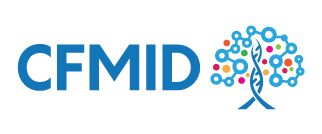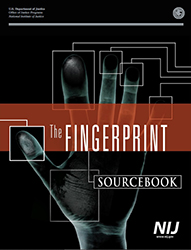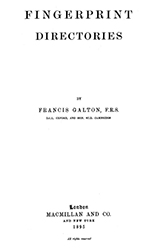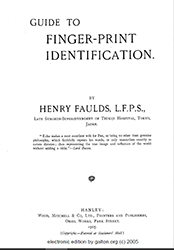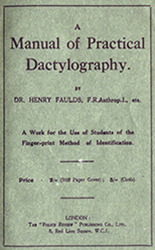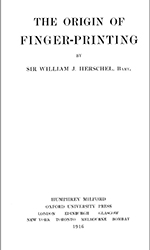
Dermatoglyphics
 Dermatoglyphics is the study of ridged skin patterns (also known as dermatoglyphs) which can be found on fingers, palms, toes and soles. These patterns are formed from the external ectoderm and usually occur during the fetal development stage, 13 to 19 weeks after fertilization. Through research, geneticists have proven that Dermatoglyphs formations are controlled by chromosomes, and the patterns are influenced by polygenetic inheritance. These genes do not exhibit dominance, and they are very resistant to acquired changes from the environment. Using their morphologies, the patterns can be classified into two categories, namely “ridges” and “furrows”. During the seventh week of pregnancy, vertical thumb creases (thenar contours) begins to appear on the palm of the embryo. Two weeks later, remote and proximal horizontal creases (hypothenar contours) begin to form.
Dermatoglyphics is the study of ridged skin patterns (also known as dermatoglyphs) which can be found on fingers, palms, toes and soles. These patterns are formed from the external ectoderm and usually occur during the fetal development stage, 13 to 19 weeks after fertilization. Through research, geneticists have proven that Dermatoglyphs formations are controlled by chromosomes, and the patterns are influenced by polygenetic inheritance. These genes do not exhibit dominance, and they are very resistant to acquired changes from the environment. Using their morphologies, the patterns can be classified into two categories, namely “ridges” and “furrows”. During the seventh week of pregnancy, vertical thumb creases (thenar contours) begins to appear on the palm of the embryo. Two weeks later, remote and proximal horizontal creases (hypothenar contours) begin to form.
Hirsch and Schweicher discovered that prior to the formation of dermatoglyphs, the dermal nerves and blood vessels are arranged in an orderly fashion. This led them to believe that the nervous and vascular systems determine the formation of dermatoglyphs. Consequently, they also established the correlation between the Dermatoglyphics patterns and one’s personalities.
From the anatomical point of view, the human hands dominate all other organs in terms of relative importance. This is why the brain dedicates the majority of approximately two hundred million nerve endings to the hands. In other words, the hands are sources of physiological and psychological information waiting to be tapped, hence the increasing importance in the field of Dermatoglyphics.
Dermatoglyphics features

When the fetus is in the mother’s womb, the life area of the fetus’ brain is developed. From 0-3 years old, the emotional area develops rapidly. Between 4-8 years old, the thought function/area is developed. Whereas, between 9-16 years old the mental/spiritual part gradually matures. Hence, after 17 years, “want” and “do not want” become the brain’s main model of operation.
The human brain is like a computer, 0-3 is equivalent to the hardware phase, 4-8-year-old is equivalent to the software phase, and above 9 years old is equivalent to the operational phase, namely practice using the computer
Uniqueness
There are no two identical fingerprints. One’s 10 fingers are not the same including dermatoglyphics style, strip height, density, quantity and location of the point is not the same as the trigeminal.
Invariance
The raised pattern network of lifetime from birth to death will not change even if it is due to the regeneration of the labor.
Hereditary
According to science statistics, immediate family members will be more or less the same between the striae. Normal human cells have 23 pairs of chromosomes. If the chromosomes of the tree or structure are changed, it will cause the corresponding striae mutation. Therefore, the striae have inherited the mutation.
HISTORY OF DERMATOGLYPHICS
-
Ancient India
The study of fingerprint pattern has a reference in Hastasamudrika Shastra which is a part of Vishnu Puran.
-

Dr. Nehemiah Grew (1641-1712) presented Finger Prints, Palms and Soles An Introduction To Dermatoglyphics to the Royal Society
-
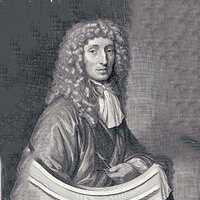
Dr.Bidloo published an anatomical atlas, Anatomia Humani Corporis, with illustrations showing the human figure both in living attitudes and as dissected cadavers
-

Dr. Marcello Malphigi (1628-1694) noted in his treatise; ridges, spirals and loops in fingerprints
-
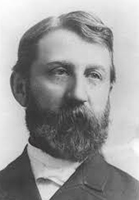
J.C.Mayer was the first to write out basic tenets of fingerprint analysis and theorized that fingerprints were unique
-

Joannes Evangelista Purkinji found that the patterns on one’s finger tips and the ridges and lines on one’s prints begin to form at around the thirteenth week in the womb.
Dr. Jan Purkinje classified the papillary lines on the fingertips into nine types: arch, tented arch, ulnar loop, radial loop, peacock’s eye/compound, spiral whorl, elliptical whorl, circular whorl, and double loop/composite.
-
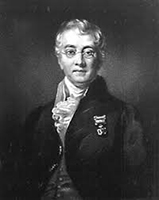
Dr. Charles Bell (1774-1842) was one of the first physicians to combine the scientific study of neuro-anatomy with clinical practice. He published a book “The Hand: Its Mechanism and Vital Endowments as Evincing Design.”
-
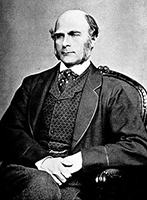
Dr. Francis Galton published his book, “Fingerprints”, establishing the individuality and permanence of fingerprints. The book included the first classification system for fingerprints: Arch, Loop and Whorl.
-
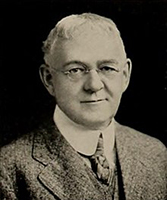
Harris Hawthorne Wilder was the first American to study Dermatoglyphics. He invented the Main Line Index, studied thenar hypothenar eminencies, zones II, III, IV.
-

Dr. Harold Cummins & Dr. Charles Midlo coined the term “Dermatoglyphics”. They showed that the hand contained significant Dermatoglyphics configurations that would assist the identification of mongolism in the new-born child.
-

Dr. Harold Cummins & Dr. Charles Midlo also researched the embryo-genesis of skin ridge patterns and established that the fingerprint patterns actually develop in the womb and are fully formed by the fourth foetal month.
-

Dr Julius Spier Psycho-Analytic Chirologist published “The Hands of Children” he made several significant discoveries especially in the area of psycho-sexual development and the diagnosis of imbalances and problems in this area from the patterns of the hands.
-

Dr.Walker used the dermal configurations in the diagnosis of mongolism
-
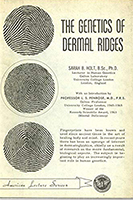
Sarah Holt, whose own work ‘The Genetics of Dermal Ridges’ published in 1968, summarizes her research in dermatoglyphics patterns of both the fingers and the palm in various peoples, both normal and congenitally afflicted.
-

John J. Mulvihill, MD and David W. Smith, MD published The Genesis of Dermatoglyphics that provides the most up to date version of how fingerprints form.
-

USSR, Former Soviet Union. Using Dermatoglyphics in selecting the contestant for Olympics.
-
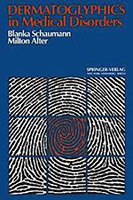
Schaumann and Alter’s ‘Dermatoglyphics in Medical Disorders’ published.Significant investigations have also been carried out into the dermatoglyphics indicators of congenital heart disease, leukaemia, cancer, rubella embryopathy, Alzheimer’s disease, schizophrenia etc.Dermatoglyphics research being directed into genetic research and the diagnosis of chromosomal defects.
-
China carry out researching work of human potential, intelligence and talents in dermatoglyphics and human genome perspective.
-
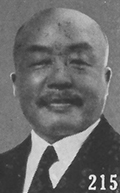
Dr. Chen Yi Mou Phd. of Havard University research Dermatoglyphics based on Multiple Intelligence theory of Dr. Howard Gardner. First apply dermatoglyphics to educational fields and brain physiology.
-
Dr Stowens, Chief of Pathology at St Luke’s hospital in New York, claims to be able to diagnose schizophrenia and leukaemia with up to a 90% accuracy. In Germany, Dr Alexander Rodewald reports he can pinpoint many congenital abnormalities with a 90% accuracy.
-

Edward Campbell founded IBMBS- International Behavioral & Medical Biometrics Society. Nowadays the U.S., Japan, China, Taiwan apply dermatoglyphics to educational fields, expecting to improve teaching qualities and raising learning efficiency by knowing various learning styles.

How to Discover Your Inborn Ability
We all have talents. No one has all talents. With Dermatoglyphics, a revolutionary system to help an individual to identify their talents, to build them into strengths, and to enjoy the constituent, as well as to fulfill the ultimate need of self-actualization. Inborn Potential Assessment is a system that identifies the most prevalent human intrinsic potential with the theory of human genetic inheritance.
The system identifies and introduces logical versus creative nature, Dominant Personality Types, Learning Styles. With thousands of possible combinations, one can use this for growth and development in education, in personal and in career domains.
What make this study works?
As we know, our left hand represents our right brain and right hand represents our left brain. Here’s the same theory has been applied on this system of Dermatoglyphics.
Application of Dermatoglyphics
Parents
- Helps child to develop their inborn strong and advantageous fields.
- Reinforces child’s area of improvement and provide a suitable learning method.
- Enables children to learn effectively.
Students
- Helps to choose a suitable learning style and method
- Helps to choose a suitable course / career / area of development depending on one’s strengths.
Adults
- Helps to fully understand our strong and not so strong fields.
- Helps us to know our most suitable learning style and to position ourselves in the most suitable field of occupation / nurture inborn talents at a mid career stage.
Corporate
- Helps in managing human resources more effectively. Task allocation can be undertaken based on employee’s inborn strong areas.
- Helps HR Team to understand the inborn abilities, attitude, skill potential and knowledge areas.
Benefits of Dermatoglyphics
Comprehensive
Objectivity
Stability
No age limit
Simple
Understand your child’s innate characteristic
- Saves time and effort of Parents in understanding their children. The report shares ample knowledge of the child’s inborn characteristics (curious, aggressive, rebellious, persistent etc.)
- To understand and to develop an effective way to interact with your child based on their inborn communication style.
- For adults,this test can be used for self evaluation and compatibility with family, spouse or business partner.
Know your child’s inborn leaning style or ability
- To know exactly the natural learning style a child posses A kinesthetic learner is good in expressing their feeling/thought through body language and prefers to learn/memorize through operation and movement, A visual learner has sharp observation/visual differentiation and prefers to learn through observation and reading, An auditory learner prefers to learn through auditory sense/oral practice and able to assimilate, organize and arrange oral information
- To recommend parent to place their child in courses or pre-school where its curriculum suits the child’s inborn learning style.
- To eliminate the ‘trial and error’ situation when parents send their child to a certain class (i.e. art class or music class) without knowing if the child is capable to comprehend and pursue the course for a longer period of time.
- As for adults,this test will reveal to them the strength they possess and to guide them to perform better at work
Discover Hidden talent & Potential
- Every child is unique and they possess different inborn talents
- To give parents an insight into their child and to groom them effectively according to the talents they possess
- To enable parents to focus on their child’s strength and to eliminate the ‘guessing game’ on their talent
- Dermatoglyphics report is a very important guideline for a child to refer when choosing university major that best suit their inborn abilities and potential
- For Post Graduates, the dermatoglyphics report will be helpful in giving recommendation to chose their career through the job path / venture into a startup entrepreneurial journey
- As for adults,this test can be a very good reference for those who intend to make a mid career change, to venture into new business or to pick up new skill/education
SOME OF THE AUTHORS WHO HAVE MADE A SIGNIFICANT CONTRIBUTION ARE GIVEN BELOW:
Faulds (1905), Hellwig (1912), Carriere (1923). Ganther (1923), Roscher (1925), Furuhata (1927). Heindl (1927), Bonnevie (1929), Cummins (1930, 1934, 1961), Metiner (1930), Gerke (1932), Harster (1932), Saller (1932), Abel (1933, 1935), Geipel (1935, 1937), Kirchmair (1936), Csik (1927), Henry (1937), MacArther (1937), Pol (1937), Dankmeijer (1938), de Pina (1939), Okuma (1940), Kumbnani (1959, 1968, 1972, 1978, 1984, 1990, 1991, 2005), Singh (1961), Volotzkoy (1961), Bali (1968), Sen (1968), Clercil (1969), Bhanu (1975) Mavalwala (1977), Singh and Bhasin (1979), Livshits (1987), Micle (1988), Kamali (1990), Bhasin and Walter (2001).
